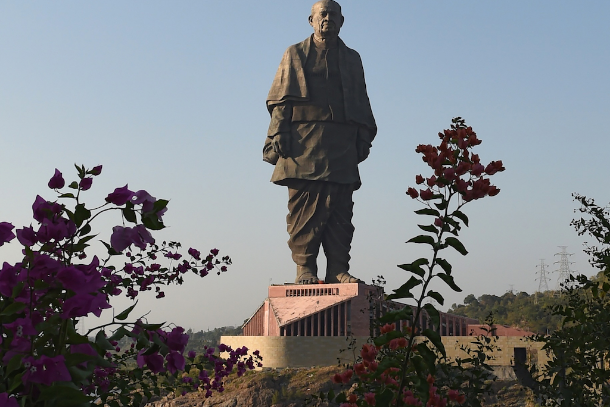$430m tribute to independence leader is dismissed as a gimmick to help Narendra Modi’s BJP in next year’s elections

The Statue Of Unity, the world’s tallest statue dedicated to Indian independence leader Sardar Vallabhbhai Patel, stands overlooking the Sardar Sarovar Dam near Vadodara in India’s Gujarat state on Oct. 30. (Photo by Sam Panthaky/AFP)
Rights groups, environmentalists and farmers’ leaders were aghast as Indian Prime Minister Narendra Modi unveiled the world’s tallest statue costing US$430 million.
The 182-meter-high Statue of Unity, the towering figure of India’s first deputy prime minister and independence leader Sardar Vallabhbhai Patel, is almost four times bigger than the 46-meter Statue of Liberty in New York.
The iron and bronze statue, unveiled on Oct. 31, looks over the Narmada River in Gujarat, the home state of both Modi and Patel, in western India. The project began in 2013 when Modi was the state’s chief minister.
The federal government planned the project as a tribute to Patel, a leader of Modi’s rival Congress party. He was known as India’s iron man for his work to unite 513 princely states to create the Indian federation after British rule ended on the subcontinent in 1947.
However, the project has faced criticism for spending a huge amount in a country beset with malnutrition, illiteracy, poor infrastructure and a lack of essential healthcare facilities.
The World Health Organization ranked India 130th of nations in considering its poor human development indices such as maternal mortality, neonatal mortality, health financing and availability of facilities.
Pravin Mishra, a Gujarat-based civil rights activist, said some of the statue’s cost would have been enough to help debt-trapped farmers who are committing suicide to escape bank loans.
The National Crime Records Bureau recorded that 11,370 farmers committed suicide in India in 2016 alone. On May 3 this year, the government admitted that more than 12,000 farmer suicides had been reported in the country every year since 2013.
It shows that every hour a farmer kills himself unable to repay a loan taken from the government, Mishra said.
At least half of India’s 1.2 billion people depend on farming, which contributes 15 percent to GDP.
Mishra said that instead of building statues the government should have worked to improve the country’s Hunger Index ranking.
Villagers in Narmada district also feel the project shows the government’s flawed interests. Heads of 22 villages wrote an open letter to Modi saying he would not be welcomed for the unveiling of the statue, media reports said.
Former Gujarat chief minister Suresh Mehta, who opposed Modi and resigned from the pro-Hindu Bharatiya Janata Party (BJP), said the project was illegal because the government did not do a mandatory environmental impact assessment.
The project is only “meant for publicity. It is a politically motivated project keeping in mind the 2019 elections,” Mehta told media on Oct. 19.
Vinay Kumar of the National Federation for Dalit Land questions the benefit of the statue to the people.
“What is the fun in this when more than 1.5 million Indians live on the streets? It would have been better to tackle poverty than spending on a statue,” Kumar told ucanews.com.
Environmentalist Rohit Prajapati and several activists who protested the project were detained on Oct. 30.
Prajapati maintains the project will adversely affect the environment. It “is bound to damage” the Narmada River and biodiversity, people living downstream and their livelihoods,” he told media ahead of his arrest.
The river is a source for irrigation in 12 districts of Gujarat and provides flood protection to 210 villages.
Social activist Anjali Bharti said the statue has political symbolism to help the pro-Hindu BJP.
Although Patel was a Congress party leader, he was widely seen as pro-Hindu and “has become a right-wing icon for Hindu nationalists. And his statue has been built in a state that has witnessed the fiercest clashes between Hindus and Muslims in the past. There is more to it than meets the eye,” said Bharti.
The deadliest communal riots in Gujarat took place in 2002 when more than 2,000 people, mostly Muslims, were killed.
Two more statues are being constructed in other BJP-ruled states. In Maharashtra, a 61-meter statue of Shivaji, the 17th century Maratha king who resisted Muslim rule, is being built, while Uttar Pradesh will host a 91-meter statue of Hindu god Rama. Each statue will cost an estimated US$300 million.
The statues are meant to placate Hindu feelings and help Modi’s party in the national elections due next May, his critics say.
Hindus form 966 million or 80 percent of India’s population of 1.2 billion. Muslims account for 172 million or 14 percent while Christians comprise 29 million or 2.3 percent.
